According to the CBSE Syllabus 2023-24, this chapter has been renumbered as Chapter 6.
Class 10 Science Notes Chapter 7 Control and Coordination
Introduction
The human body is a complex machine performing tons of functions and processes to maintain and sustain life. Explore how the body controls its movements and coordinates its actions with other parts of the body and the environment by exploring notes for Class 10 Chapter 7 Control and Coordination.
The Nervous System
Movement in Organisms
The ability of organisms to move certain body parts is movement.
When they move from one place to another, it is called locomotion.
Organisms show movements in response to stimuli.
Introduction to Control & Coordination
- Organisms move in response to various kinds of stimuli like light, heat, nutrients/food, etc.
- All the activities in animals are controlled and coordinated by the nervous and endocrine systems.
- Hormones are chemical messengers which assist the nervous system in carrying out various functions. They are secreted by endocrine glands.
- Hormones in plants coordinate the movements.
For more information on Nervous System, watch the below video
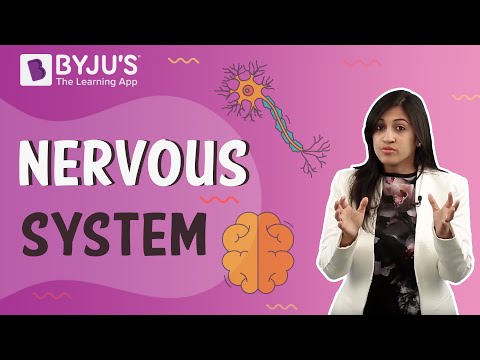
To know more about The Nervous System, visit here.
The Nervous System

Neuron
Neuron is the structural and functional unit of the nervous system.
- Each neuron has three main parts: dendrites, cyton/soma/cell body and axon.
- Dendrites receive impulses from other neurons.
- Cyton/soma processes the impulse.
- Axon transmits the impulse, either to another neuron or to muscles/glands, etc.
- Axon may be myelinated or non-myelinated.
- The impulse transmission is faster in myelinated neurons.
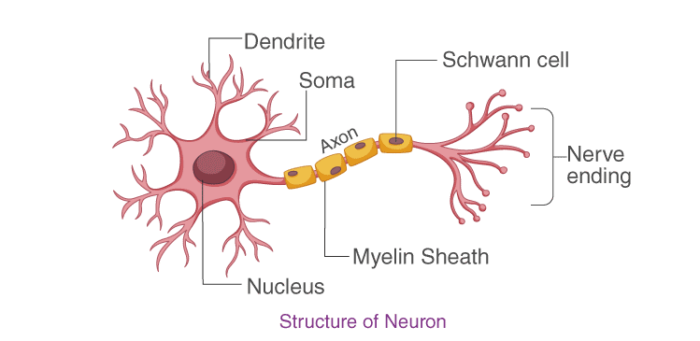
Central Nervous System
The central nervous system (CNS) is made up of the brain and the spinal cord. The functions of different parts of the brain are:
- The cerebrum is responsible for reasoning, logic, emotions, speech, memory, visual processing, recognition of auditory and taste stimuli, etc.
- Cerebellum regulates and coordinates body movements, posture and balance.
- Pons relays signals from the hindbrain to the forebrain.
- Medulla Oblongata controls all involuntary movements like vomiting, sneezing, yawning, heartbeat, breathing, blood pressure, etc.
- Medulla oblongata continues as the spinal cord, which runs through the vertebral column and it controls reflex actions.
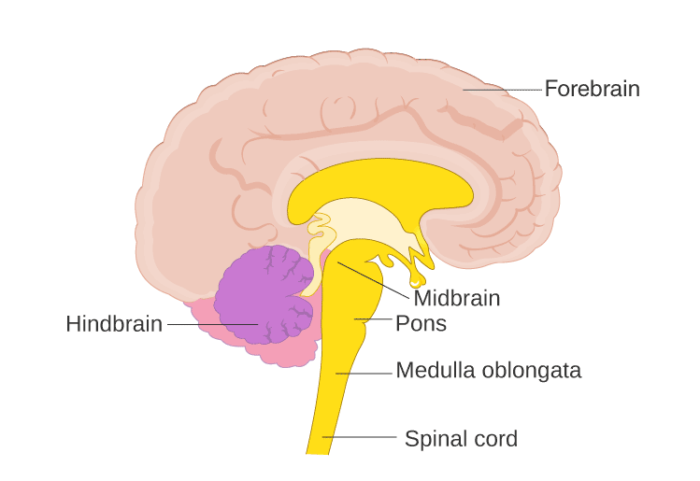
Read more: Central Nervous System
Peripheral Nervous System
- The nerves coming out from the brain and the spinal cord constitute the peripheral nervous system (PNS).
- There are 12 cranial nerves and 31 spinal nerves in humans.
Read more: Peripheral Nervous System
Somatic Nervous System
- It forms a part of the PNS.
- The nerves of PNS that control the voluntary actions of the body form the somatic nervous system.
Autonomic Nervous System
- All the nerves of the PNS that control the involuntary actions in the body form the autonomic nervous system. E.g. respiration, heart rate, blood pressure, digestion, etc., are regulated by the autonomic nervous system.
- Two divisions of the autonomic nervous system are the sympathetic and parasympathetic nervous systems.
- The sympathetic nervous system prepares the body for intense physical activity and is often referred to as the fight-or-flight response, while the parasympathetic nervous system has almost the exact opposite effect and relaxes the body and inhibits or slows many high-energy functions.
Reflex Action
Reflex action is a sudden, involuntary reaction of the body in response to stimuli.
To know more about Reflex Action, visit here.
Reflex Arc
- It is the path followed by an electrical impulse during a reflex action.
- The impulse travels from the receptor organ to the spinal cord/brain. It is processed there, and the information is brought back to the concerned muscle to carry out the action.
- Thus, the receptor organ, sensory/afferent neuron, interneuron, motor/efferent neuron and effector organ are the components of a reflex arc.
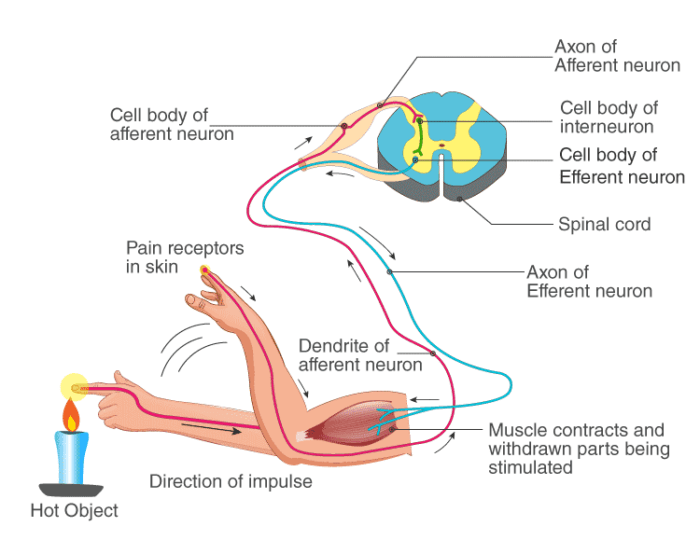
Protection of CNS
The brain is protected by 3 main layers –
- The bony skull (cranium)
- The cerebrospinal fluid
- The meninges (Dura mater, Arachnoid and Pia mater).
For more information on Brain, watch the below video
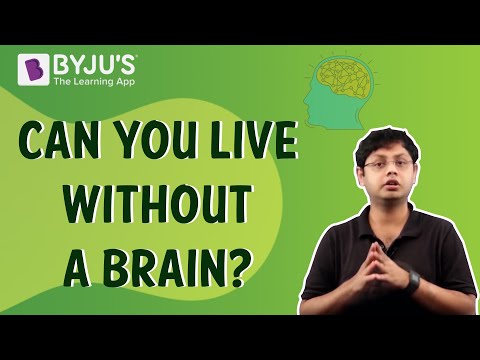
Plant Hormones and Movements
Plant Hormones
Control and coordination in plants are carried out by hormones.
| Plant Hormone | Function |
| Auxin | Helps in the growth of plant tissues |
| Cytokinin | Promotes cell division, delays ageing of cells |
| Gibberellins | Helps in the growth of stems, initiates seed germination, promotes flowering, cell division and seed growth after germination |
| Abscisic acid | Inhibits growth and causes wilting of leaves, promotes dormancy of buds and seeds |
| Ethylene | This is a gaseous hormone which causes the ripening of fruits |
To know more about Plant hormones, visit here.
Growth Independent Movements
The movements which are not growth related are called nastic movements. These movements occur in response to environmental stimuli but the direction of response is not dependent on the direction of the stimulus.
- The movement in the touch-me-not plant is thigmonastic movement (movement in response to touch).

Growth-Related Movements in Plants
The movements which are growth related are called tropic movements. These movements occur in response to environmental stimuli and the direction of the response is dependent on the direction of the stimulus.
For more information on Tropic Movements in Plants, watch the below video

To know more about Tropic Movements in Plants, visit here.
Examples:
- Phototropic movement (light-dependent)
- Geotropic movement (gravity-dependent)
- Chemotropic movement (chemical-dependent)
- Hydrotropic movement (water-dependent)
- Thigmotropic movement (touch dependent)
Geotropism
Movement of plant parts in response to earth’s gravitational force is known as geotropism/gravitropism.
- Towards gravity – positive geotropism
- Away from gravity – negative geotropism
- The root grows towards gravity, and the shoot grows away from gravity

Phototropism
Movement of plant parts in response to light is known as phototropism.
- Towards light-positive phototropism.
- Away from light – negative phototropism.
- Stems move towards the light, and roots move away from the light.
To know more about Phototropism, visit here.
Hydrotropism
Movement of plant parts in response to water or moisture.
- Towards water-positive hydrotropism.
- Away from water – negative hydrotropism.
- Again, root movement in search of water is positive hydrotropism.
- E.g. movement of roots towards high humidity level.

Chemotropism
Movement of plant parts in response to chemical stimuli is known as chemotropism.
- Towards chemical-positive chemotropism.
- Away from chemical-negative chemotropism.
- The growth of the pollen tube towards the ovule is positive chemotropism.
Thigmotropism
Movement of plant parts in response to touch is called as thigmotropism.
- Towards touch – Positive thigmotropism.
- Away from touch – negative thigmotropism.
- Movement of tendrils around the support is positive thigmotropism.

The Endocrine System
Exocrine Glands
Exocrine glands are glands that discharge secretions by means of ducts, which open onto an epithelial surface.
Endocrine Glands
Endocrine glands are the ductless glands which secrete hormones into the bloodstream in humans.
The endocrine glands present in the human body are the pituitary, thyroid, adrenal, pineal, pancreas, ovary (female), testis (male), etc. Let us now learn more about each of the glands below.

For more information on Endocrine Glands, watch the below video

To know more about Exocrine glands, visit here.
Pituitary Gland
- It is a pea-sized gland located at the base of the brain.
- It is the master gland, as it controls the secretions of all the other endocrine glands.
- It also secretes Growth Hormone (GH). Under-secretion of GH causes Dwarfism, and over-secretion causes Gigantism in children and ‘Acromegaly’ in adults.
To know more about the Pituitary gland, visit here.
Thyroid Gland
- It is a butterfly-shaped gland located in the throat.
- It secretes the hormone ‘Thyroxine’, which regulates the metabolism of the body.
- Iodine is required to synthesize thyroxine in the body.
- In the case of iodine deficiency, under-secretion of thyroxine leads to goitre.
To know more about the Thyroid gland, visit here.
Pancreas
- It is a leaf-like gland present behind the stomach in the abdomen.
- It is an endocrine as well an exocrine gland.
- As an endocrine gland, it manufactures two hormones – Insulin and glucagon. Both these hormones act antagonistically and regulate the sugar level in the blood.
- As an exocrine gland, it secretes enzymes to break down the proteins, lipids, carbohydrates and nucleic acids in food.
- An insufficient amount of insulin from the pancreas leads to diabetes.
To know more about Pancreas, visit here.
Adrenal Gland
- Occurs in pairs above each kidney.
- It decreases in size with age.
- Secrets the hormone adrenaline, which helps in flight and fight response.
- Also secretes noradrenaline.
To know more about the Adrenal gland, visit here.
Gonads
- Gonads are the gamete-producing organs – testes in males and ovaries in females.
- The testes produce the male hormone testosterone, and the ovaries produce the female hormones oestrogen and progesterone.
- Testosterone and oestrogen help in producing gametes and are responsible for the sexual characteristics of males and females, respectively.
- Progesterone is the pregnancy hormone.
To know more about Gonads, visit here.
Other Endocrine Organs
- The other endocrine organs include the hypothalamus, parathyroid, pineal and thymus glands.
To know more about The Endocrine System, visit here.
Also Check:
- CBSE Class 10 Science Notes Chapter 6 Life Processes
- CBSE Class 10 Science Chapter 8 How Do Organisms Reproduce Notes
- NCERT Solutions for Class 10 Science Chapter 7 Control and Coordination
- NCERT Exemplar Class 10 Science Solutions for Chapter 7 – Control And Coordination
- Real Numbers Class 10 Notes: Chapter 1
- CBSE Class 10 History Notes Chapter 1 – The Rise of Nationalism in Europe
Frequently Asked Questions on CBSE Class 10 Science Notes Chapter 7 Control and Coordination
What is the function of the Central nervous system?
The central nervous system (CNS) controls most functions of the body and mind. It consists of two parts: the brain and the spinal cord. The brain is the centre of our thoughts, the interpreter of our external environment, and the origin of control over body movement.
What are some facts about the human brain?
1. 60% of the human brain is composed of fat.
2. The brain contains about 100 billion neurons and 100 trillion connections.
3. The texture of the brain is similar to that of firm jelly.
How many parts does the human eye have?
The human eye totally consists of 7 parts that work together.
Comments